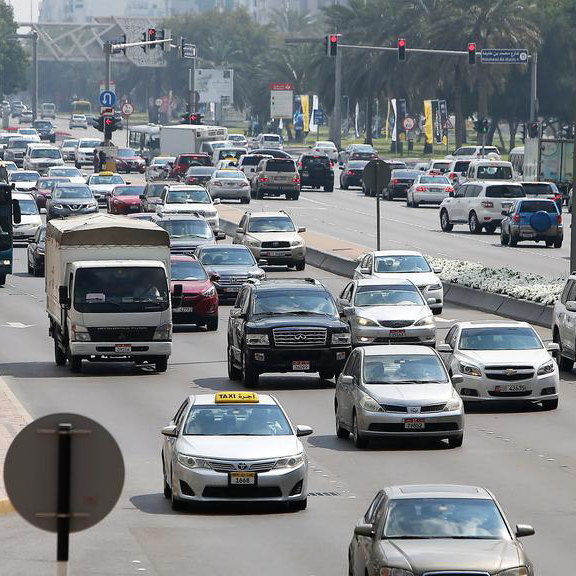Outing yourself as a 45-year-old non-driver in Abu Dhabi attracts the same mixture of disbelief, suspicion and pity that’s usually reserved for British teetotalers and vegetarians in France
In 1986, the year her government privatised and deregulated Britain’s bus networks, Margaret Thatcher is reputed to have said that: “A man who, beyond the age of 26, finds himself on a bus can count himself a failure.”
If that’s the case, then the vast majority of men in Abu Dhabi are certain winners in the great commute of life, whereas my failure is absolute: not only do I not drive, but I cannot.
In 2009, fewer than 1 per cent of men in the emirate used buses as their primary form of transport; a whopping 49 per cent used private cars, 8 per cent used private taxis and 22 per cent walked.
Only 0.3 per cent travelled by bicycle and 0.1 per cent used a motorbike, which is understandable given the suitability and safety of the UAE’s highways where, according to estimates, 5.9 road traffic fatalities were recorded per 100,000 people last year, with the number of fatalities surging by 7.4 per cent.
Outing yourself as a 45-year-old non-driver in Abu Dhabi attracts the same mixture of disbelief, suspicion and pity that’s usually reserved for British teetotalers and vegetarians in France.
“You mean you don’t drive?” people say when I confess, seemingly happier for a journalist to have a criminal record or a problem putting words in a coherent order, than an inability to steer a potentially lethal piece of machinery that travels at high speeds.
At home in the United Kingdom, where 80 per cent of the men eligible for a driving licence have one, I was happy with my minority status, but now that I live in the UAE, a place where the distances between work, home and my children’s school are vast and the love of driving runs deep, I’ve decided it’s finally time I learned to drive.
As I make my way to the Emirates Driving Company (EDC) in Mussaffah, the idea feels both liberating and rash.
It’s only 2pm in the afternoon, but homebound traffic is already hurtling thick and fast as it jockeys for position along Al Khaleej Al Arabi Street.
Four-wheel drives bank across the highway like jets in an aerobatic display, and my taxi driver, who clearly thinks that a stopping distance of three metres is more than generous, cruises behind a white Lexus at 120 kilometres per hour, sending my stress levels sky high.
After nine years in Abu Dhabi, I’m normally inured to such behaviour, but I’m now focused on the road around me as never before and I’m finding the experience alarming in the extreme.
Sending non-drivers to Mussaffah feels like a punishment that is particularly cruel. If areas such as Yas, Al Maryah and Saadiyat Islands represent Abu Dhabi’s polished super-ego, Musaffah is more like the city’s unburnished id, a bewildering labyrinth of workshops, foundries, factories and camps that become increasingly industrial and more confusing the further you venture in.
As the prize-winning author of Maximum City: Bombay Lost and Found, Suketu Mehta, confessed to me recently after he had to abandon a walking tour of the district, Mussaffah may be the place to discover Abu Dhabi’s unvarnished underbelly, but it’s no place for pedestrians.
Arriving at the vast driving-school campus, I join a knot of salwar kameez-clad fellow hopefuls who are just as eager to escape the 46°C heat, and through the heat haze before us we spy our immediate goal: the EDC test area packed with learners. A rink of infrastructure – bridges, flyovers, underpasses and car parks – designed specifically for driving instruction, it represents a condensed and uncanny simulacrum of Abu Dhabi’s urban landscape.
Before we can join in, however, we’re required to open a file, have our eyes tested, submit our documents and pay our fee, a process that takes place in a sparkling building on the far side of the campus, an anvil of melting asphalt that feels soft and sticky underfoot.
Arriving at speed, we push at doors with scalding, stainless steel handles, only to be repelled. They are locked, so we work our way around the building, desperately looking for an opening.
It’s only once we complete a circuit that we notice the sign bearing the news we had all feared: at 2.30pm, the EDC may be open for learners, but for non-drivers, registration is already closed.
Before even reaching the rink, I’ve failed my very first driving test so I leave the EDC’s car park in search of a taxi, knowing I will have to make the 60-kilometre round trip to Mussaffah all over again.
My feelings of exasperation are intense, but as a 45-year-old pedestrian in Abu Dhabi, what more did I expect?
This article was originally published in The National


